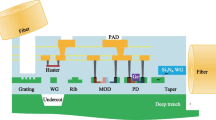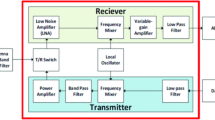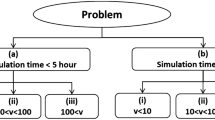Abstract
Unfortunately, the best solution for one mixed-signal design, is not the best solution for all mixed-signal designs. This is especially true in light of today's microwave applications that span the range from low-power, low-performance type of devices, through high-power, high-frequency and high-performance applications. Digital designs are automated through the use of the VHDL hardware description language, while the mixed-signal counterparts are automated using the newly developed VHDL-AMS extension. The essential ingredients for mixed-signal design fall into the methodologies of scalable functionality, robust design and feedback techniques. Scalable functionality refers to the non-conventional methodology of dimensional analysis for establishing magnitude relationships between mixed-signal system variables. Robust design of a mixed-signal system, involves the blending of the z-domain (digital) and the s-domain (continuous), resulting in the wp-domain. Robust feedback involves the inherit feedback nature of mixed-signal systems, by providing a methodology of design that emphasizes the use of feedback for achieving the desired robust system performance tolerances despite device parameter uncertainty and noise disturbances.
Similar content being viewed by others
References
G.D. Micheli, Synthesis and Optimization of Digital Circuits, McGraw-Hill Book Company, 1994.
P.W. Bridgeman, Dimensional Analysis, New Haven, Yale University Press, 1931.
B.S. Massey, Measures in Science and Engineering: Their Expression, Relation and Interpretation, Ellis Horwood Limited, 1986.
W.H. Middendorf, Design of Devices and Systems, Marcel Dekker, 1990.
C.H. Houpis and G.B. Lamont, Digital Control Systems, 2nd edition, McGraw-Hill Book Company, 1992.
I.M. Horowitz, Synthesis of Feedback Systems, Academic Press, 1963.
M. Mah, L. Liou, R.L. Ewing, and Ferendeci, "Design methodology of microstrip lines using dimensional analysis," Microwave and Guided Wave Letters, Vol. 8, pp. 248–250, 1998.
R.L. Ewing and C.H. Houpis, "QFT synthesis design for discrete flight control systems," EURISCON'98, Athens, Greece, 22-25, June 1998.
R.L. Ewing, J.W. Hines, G.D. Peterson, and M. Rubeiz, "VHDLAMS design for flight control systems," 1998 IEEE Aerospace Conference, Aspen, Colorado, 21-28, March 1998.
C.H. Houpis and R.L. Ewing, TOTAL-PC User's Manual, Air Force Institute of Technology, 1997.
P.R. Gray and R.G. Meyer, "Analysis and design of analog integrated circuits," 2nd edition, John Wiley & Sons, 1984.
W.E. Bell, R.L. Ewing, I.M. Horowitz, G.B. Lamont, and F.L. Trevino, "Object-oriented design and programming of a QFT CAD environment," Quantitative Feedback Theory Symposium Proceedings, WL-TR-92-3063, Flight Dynamics Directorate, WPAFB, OH, August 1992.
I.M. Horowitz, "Improved design technique for uncertain multiple input-output feedback systems," Int. J. Control, Vol. 36, 1982.
I.M. Horowitz, Quantitative Feedback Design Theory (QFT), Vol. 1, QFT Publications, 1993.
C.H. Houpis and G.B. Lamont, Digital Control Systems, 2nd edition, McGraw-Hill Book Company, 1992.
C.H. Houpis, "Quantitative feedback theory (QFT) for the engineer, a paradigm for the design of the control systems for uncertain nonlinear plants," WL-TR-95-3061, Flight Dynamics Directorate, WPAFB, OH.
R.L. Ewing, C.H. Houpis, and S. Rasmussen, "Robust operational amplifier performance design achieved with quantitative feedback theory," International Symposium on Quantitative Feedback Theory, Glasgow, Scotland, 20-22, August 1997.
A.S. Sedra and G.W. Smith, SPICE for Microelectronic Circuits, 3rd edition, Saunders College Publishing, 1992.
Author information
Authors and Affiliations
Rights and permissions
About this article
Cite this article
Ewing, R.L. Technology Road Map to Methodologies for Mixed-Signal System Design and Simulation. The Journal of VLSI Signal Processing-Systems for Signal, Image, and Video Technology 22, 123–134 (1999). https://doi.org/10.1023/A:1008199307327
Published:
Issue Date:
DOI: https://doi.org/10.1023/A:1008199307327




